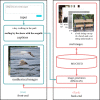Exploring the use of AI text-to-image generation to downregulate negative emotions in an expressive writing application
- PMID: 36636309
- PMCID: PMC9810434
- DOI: 10.1098/rsos.220238
Exploring the use of AI text-to-image generation to downregulate negative emotions in an expressive writing application
Abstract
Conventional writing therapies are versatile, accessible and easy to facilitate online, but often require participants to self-disclose traumatic experiences. To make expressive writing therapies safer for online, unsupervised environments, we explored the use of text-to-image generation as a means to downregulate negative emotions during a fictional writing exercise. We developed a writing tool, StoryWriter, that uses Generative Adversarial Network models to generate artwork from users' narratives in real time. These images were intended to positively distract users from their negative emotions throughout the writing task. In this paper, we report the outcomes of two user studies: Study 1 (N = 388), which experimentally examined the efficacy of this application via negative versus neutral emotion induction and image generation versus no image generation control groups; and Study 2 (N = 54), which qualitatively examined open-ended feedback. Our results are heterogeneous: both studies suggested that StoryWriter somewhat contributed to improved emotion outcomes for participants with pre-existing negative emotions, but users' open-ended responses indicated that these outcomes may be adversely modulated by the generated images, which could undermine the therapeutic benefits of the writing task itself.
Keywords: AI art; emotion regulation; image generation.
© 2023 The Authors.
Conflict of interest statement
We declare we have no competing interests.
Figures











References
-
- Sexton JD, Pennebaker JW, Holzmueller CG, Wu AW, Berenholtz SM, Swoboda SM, Pronovost PJ, Sexton JB. 2009. Care for the caregiver: benefits of expressive writing for nurses in the United States. Prog. Palliat. Care 17, 307-312. (10.1179/096992609X12455871937620) - DOI
LinkOut - more resources
Full Text Sources

